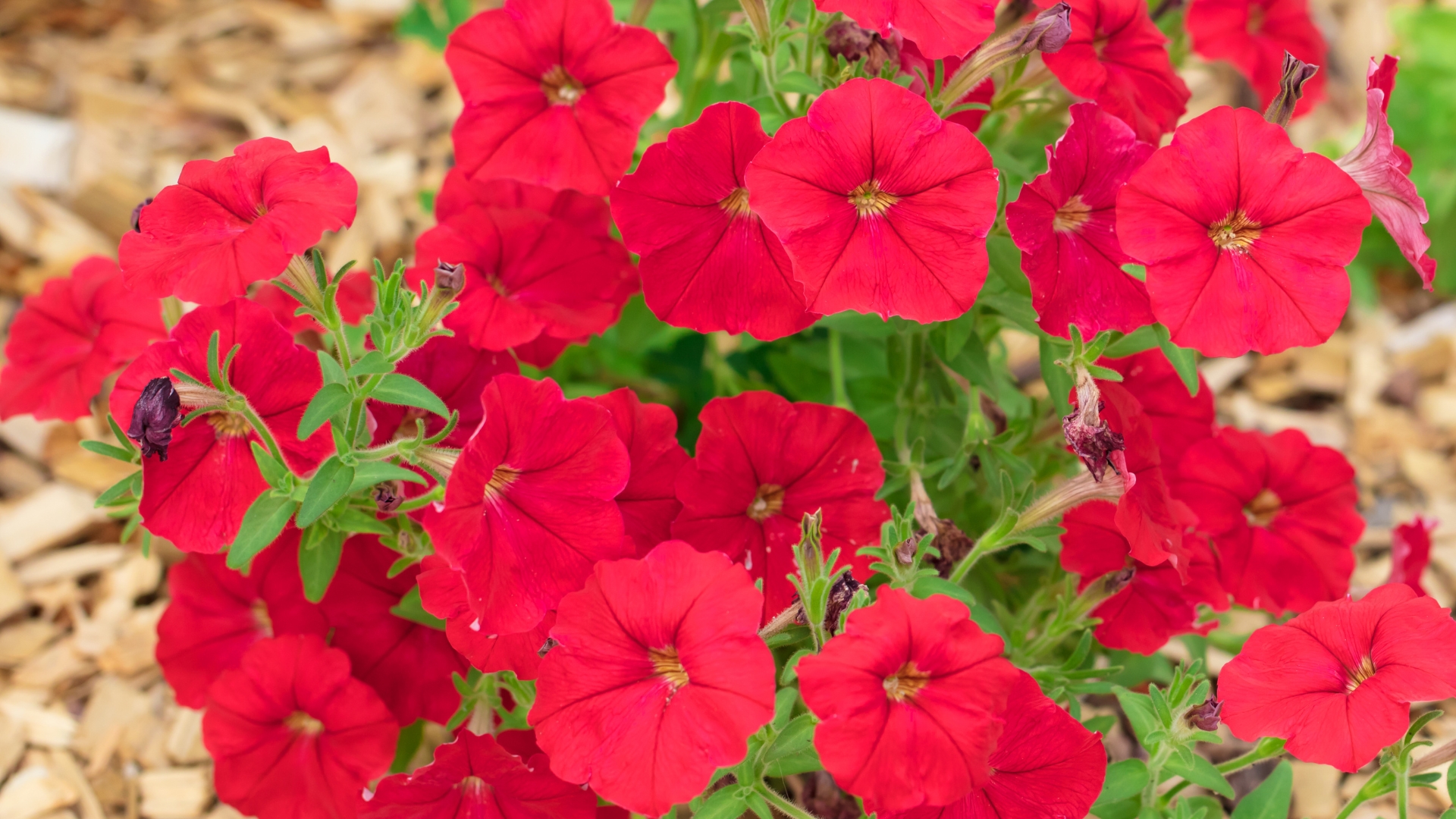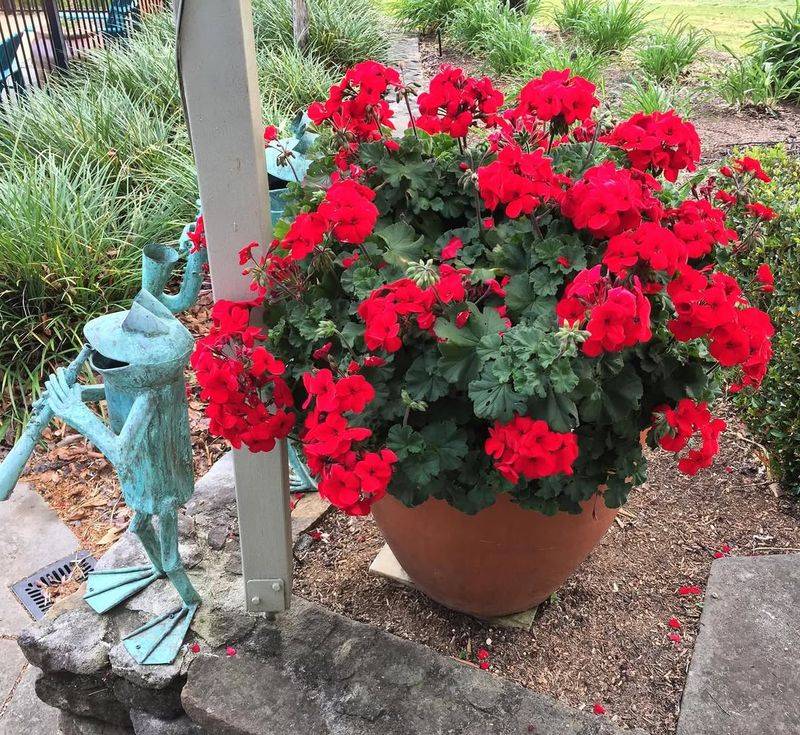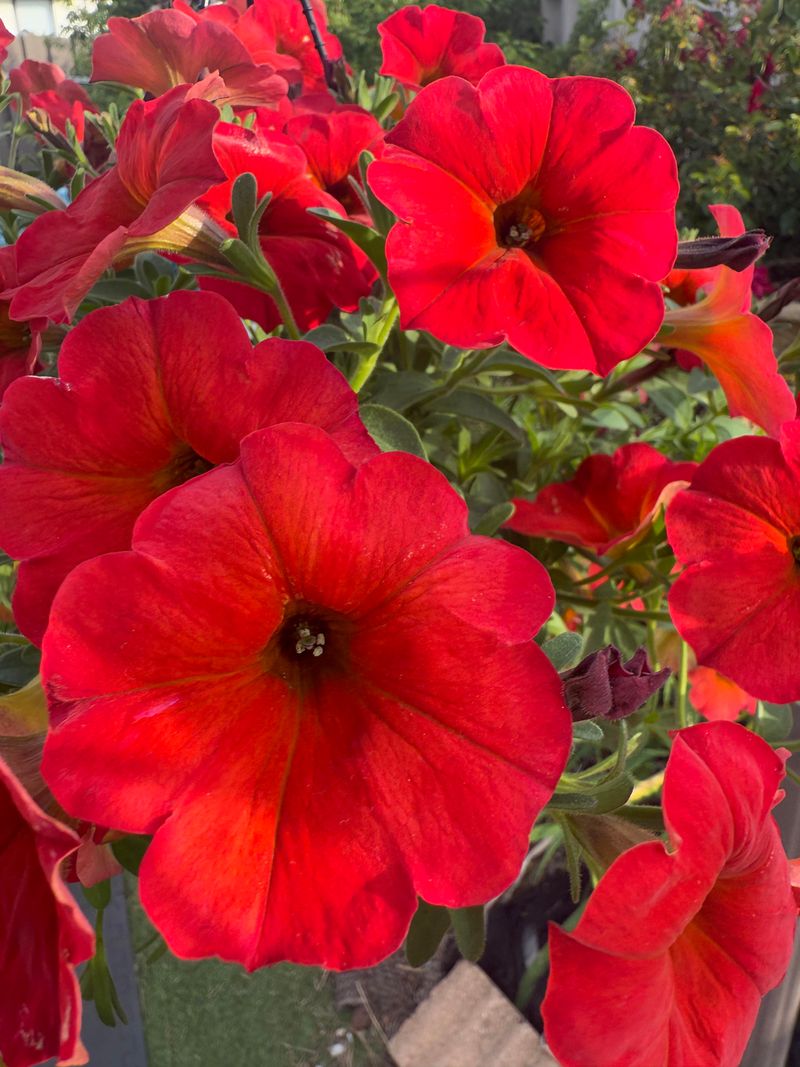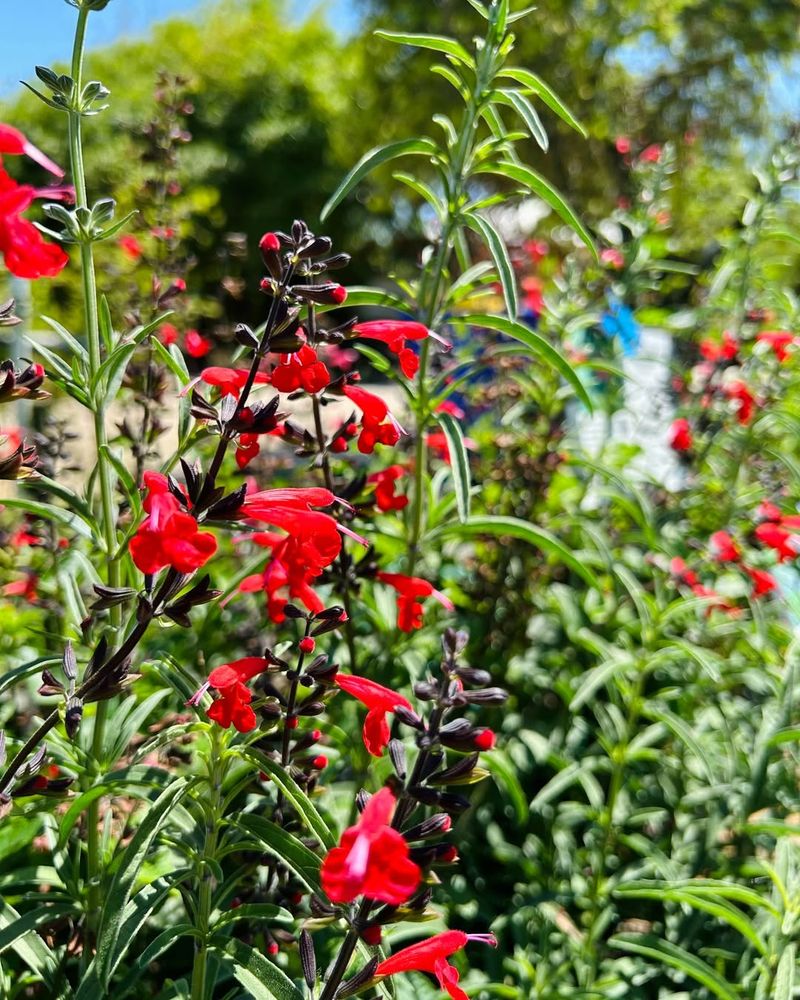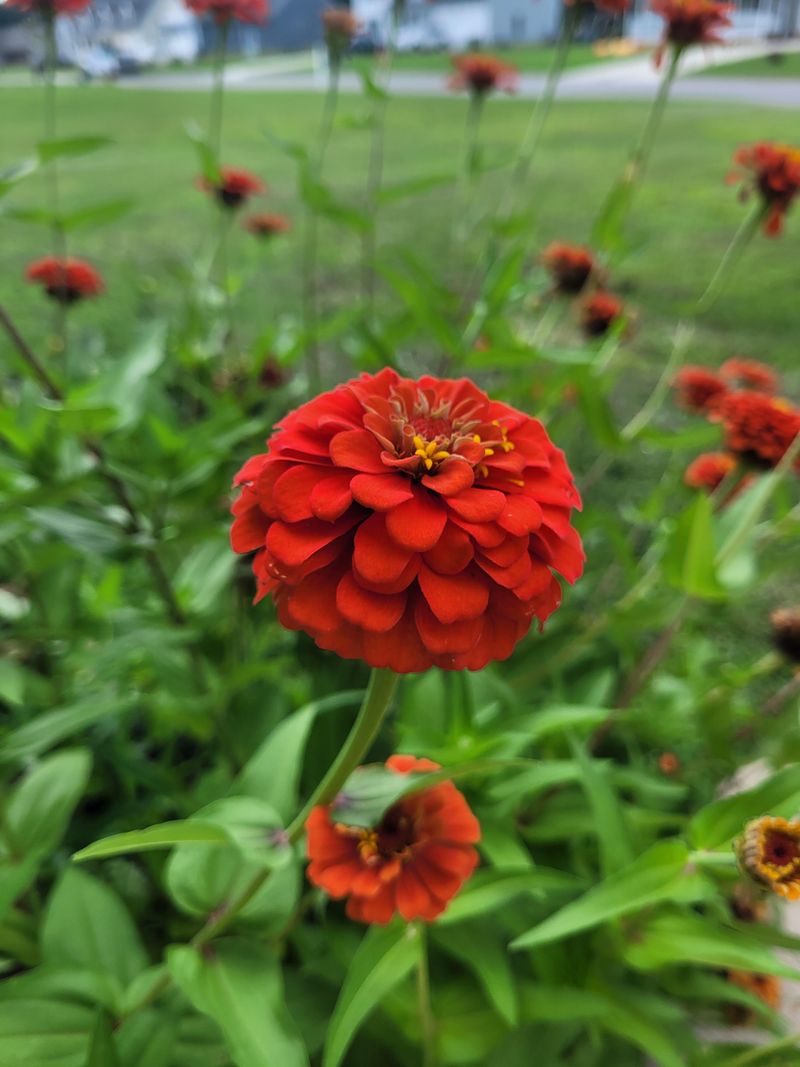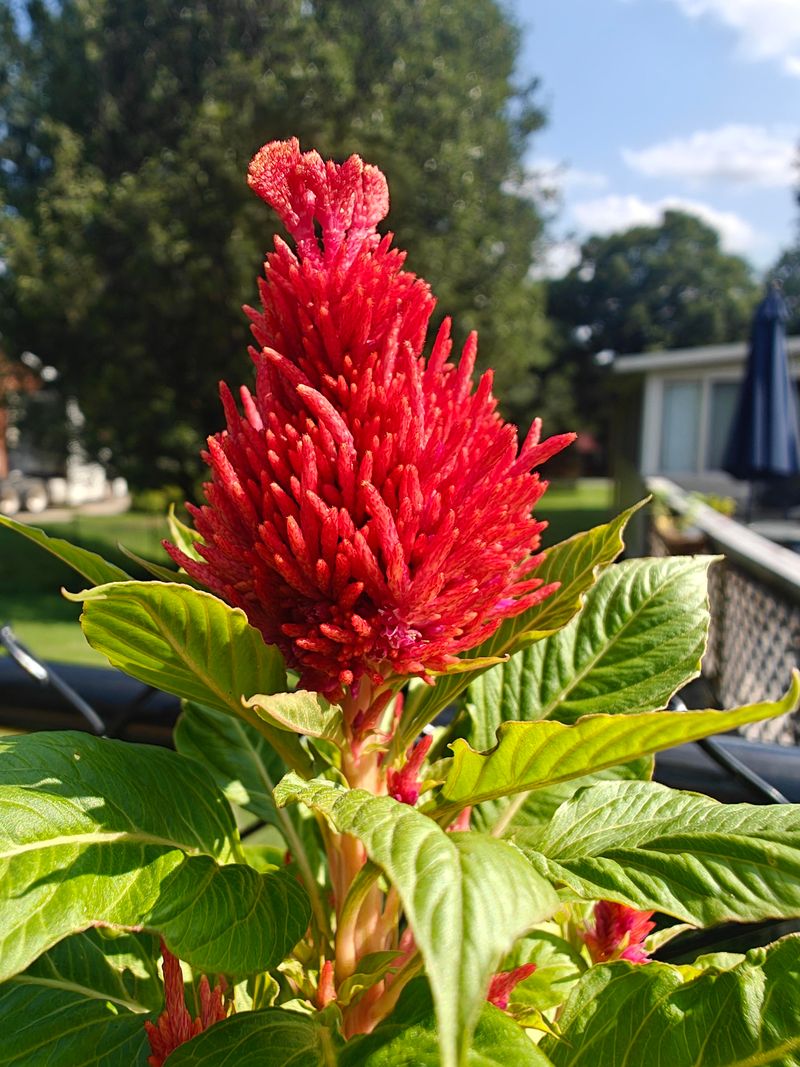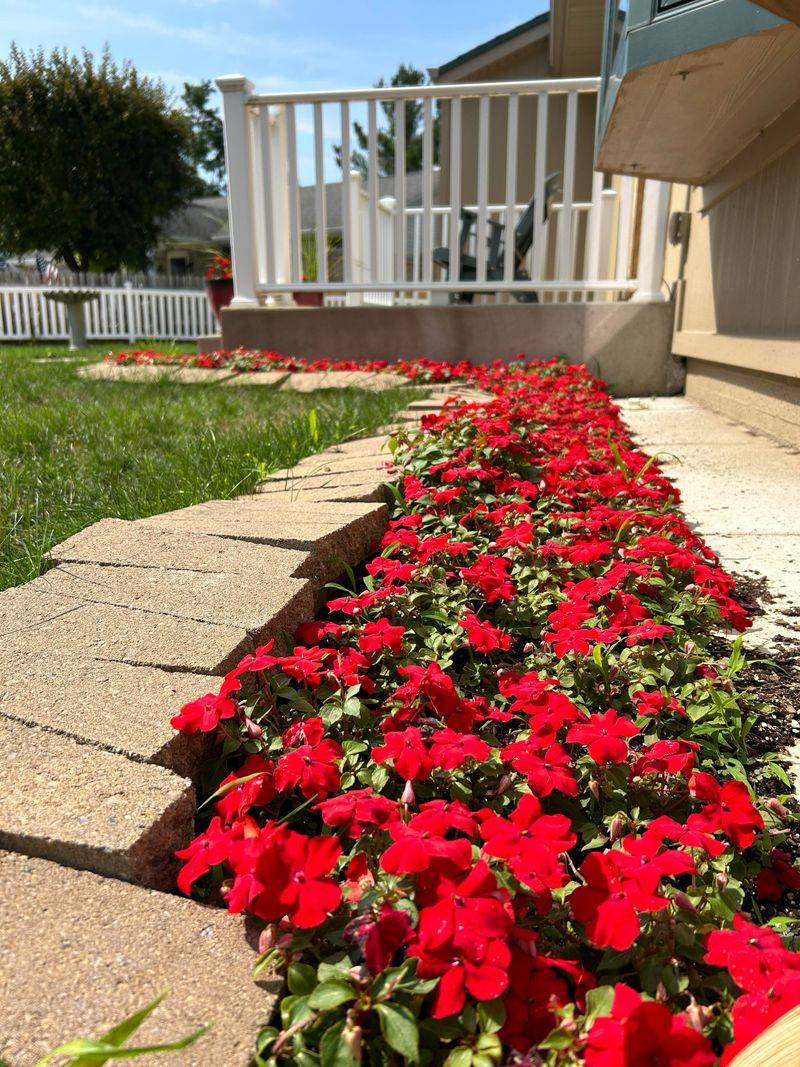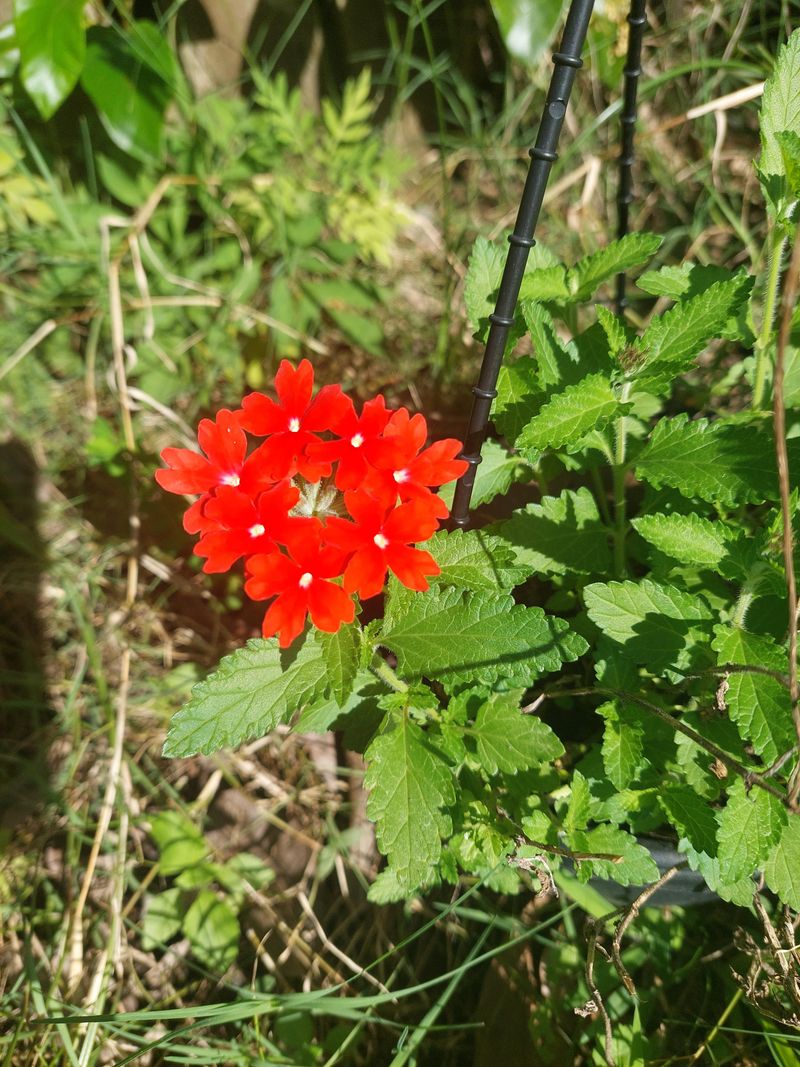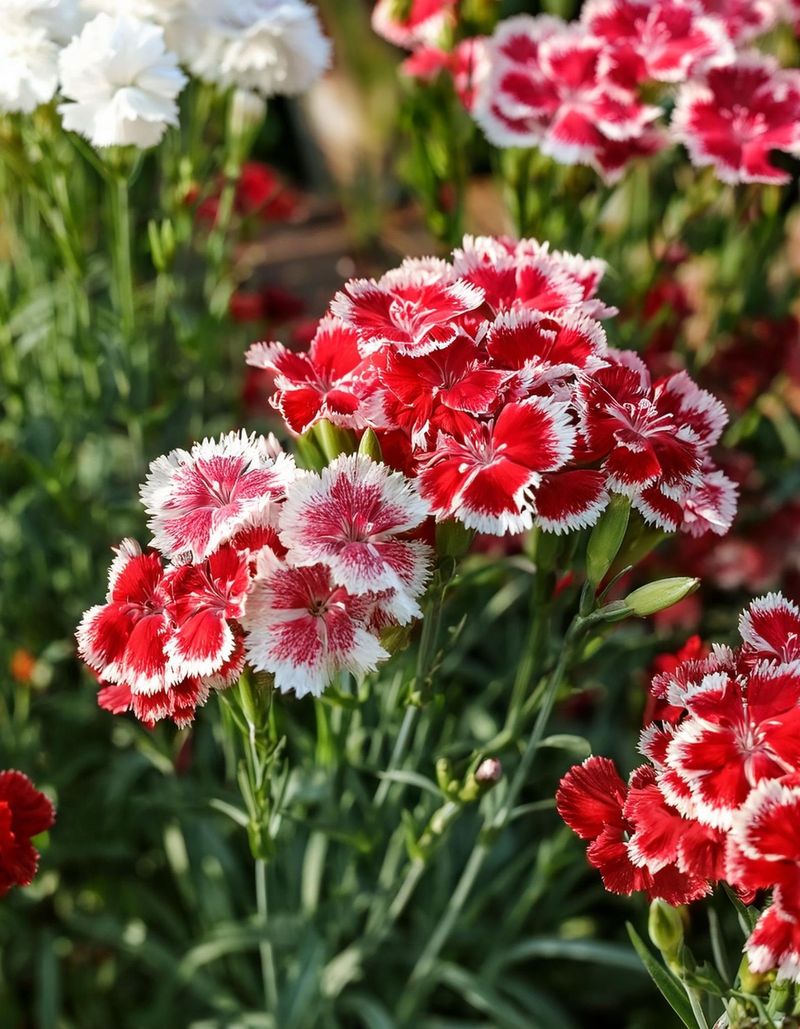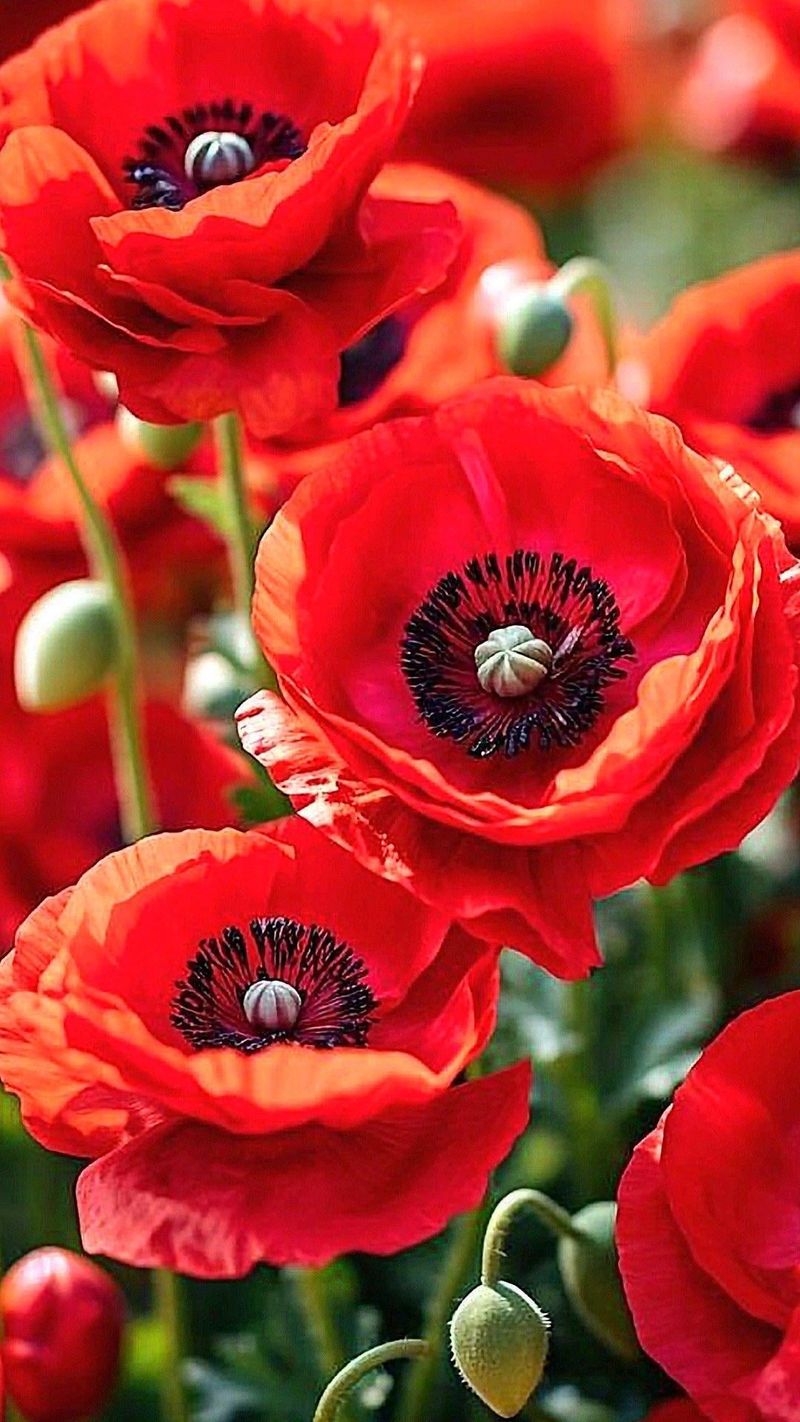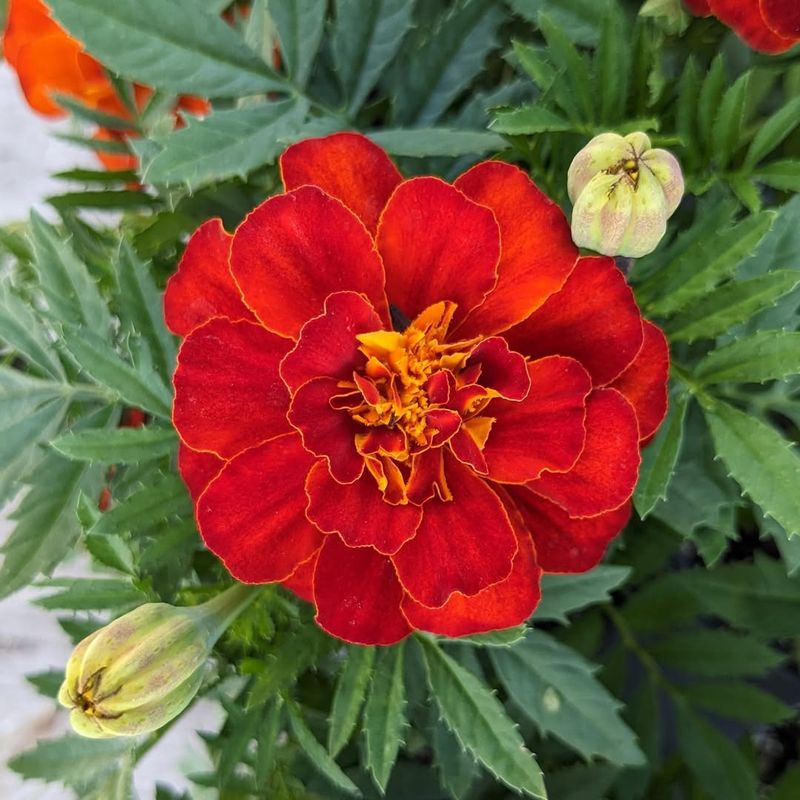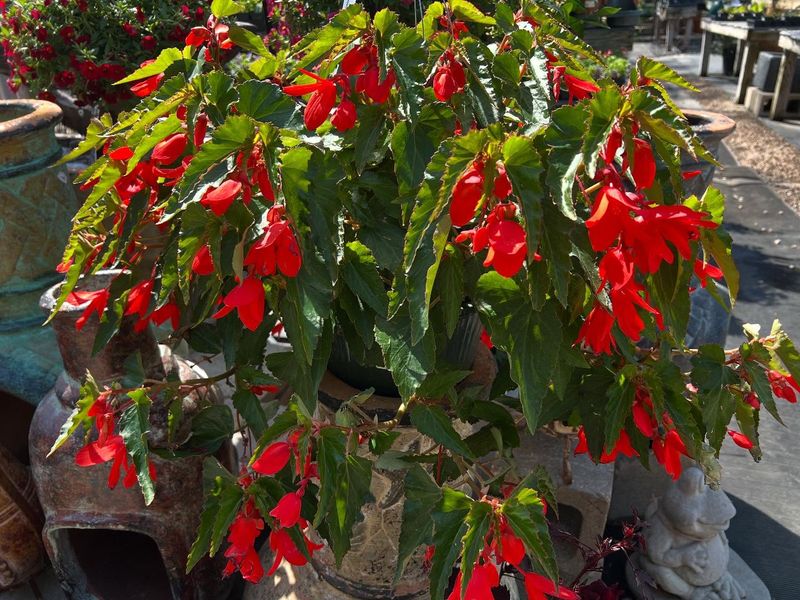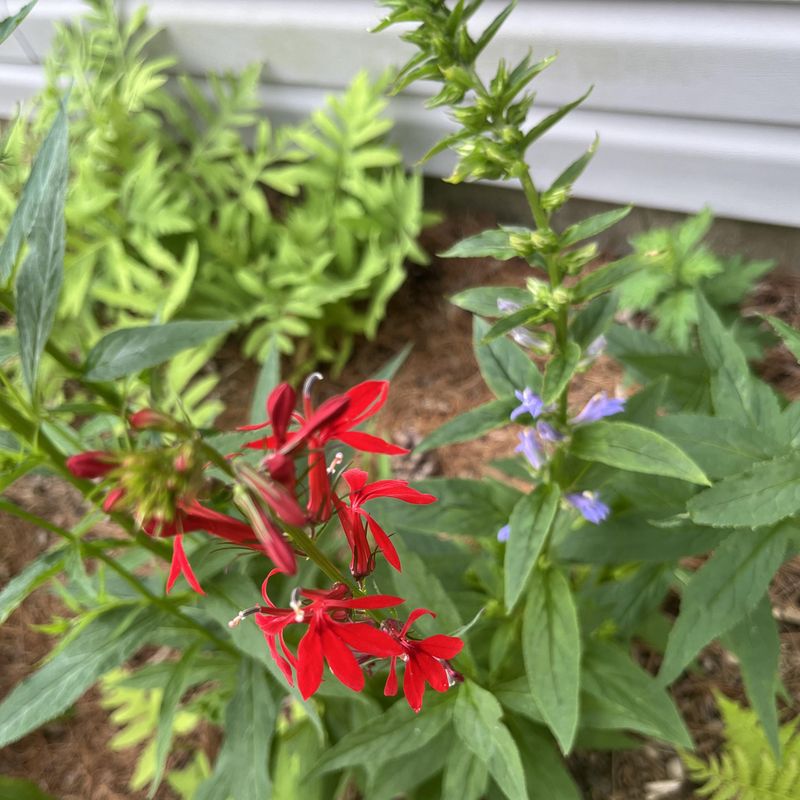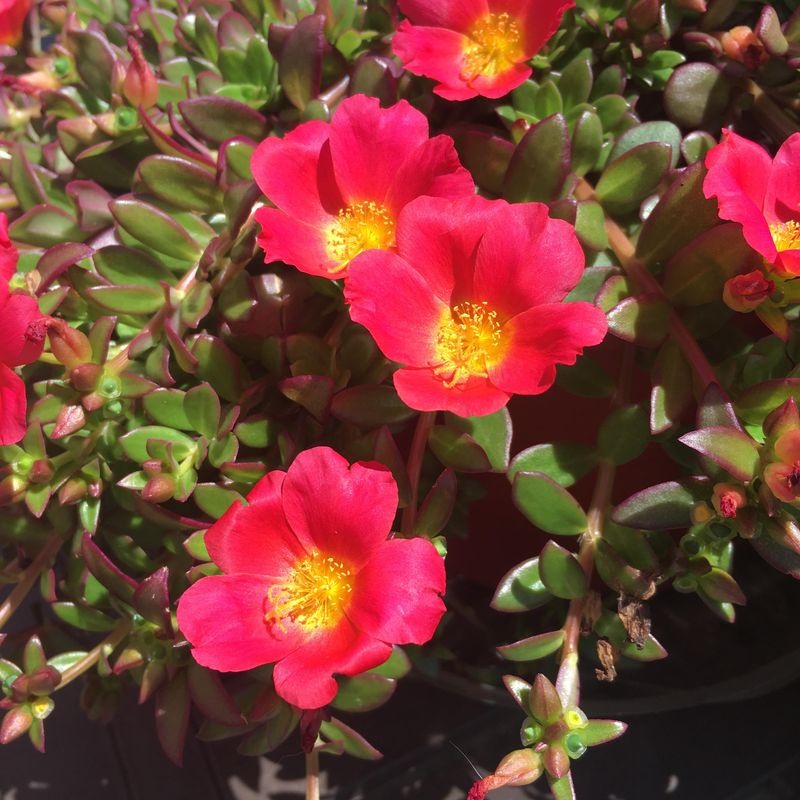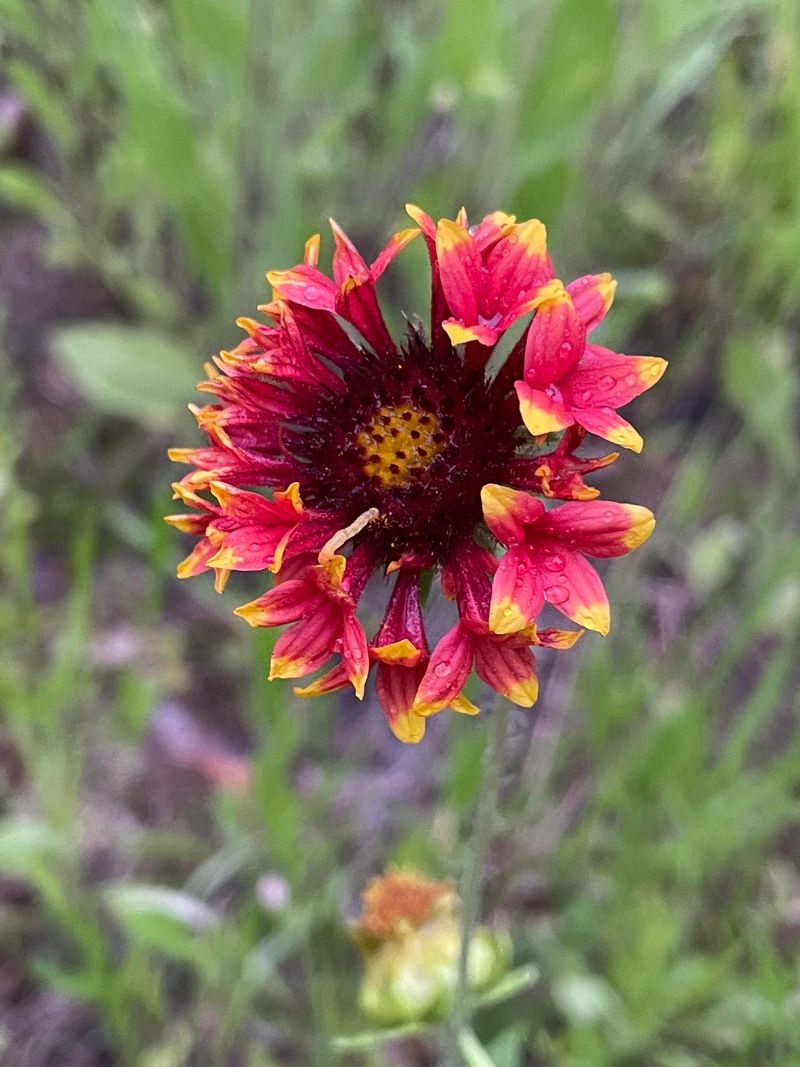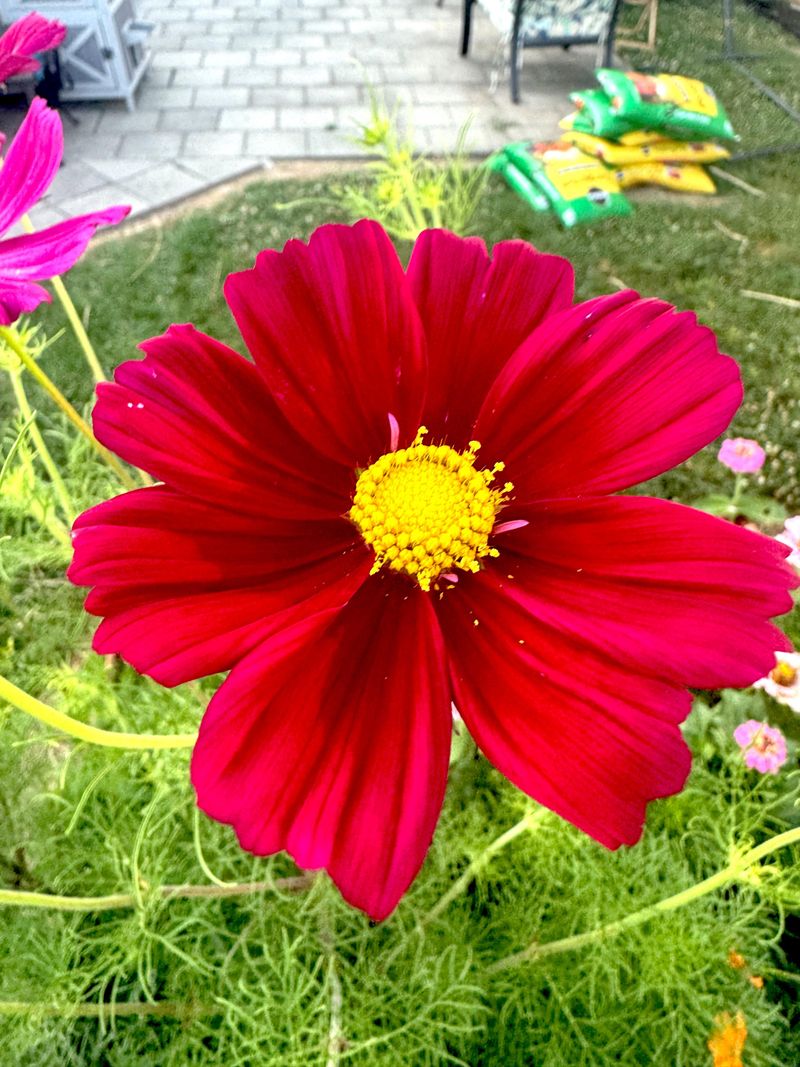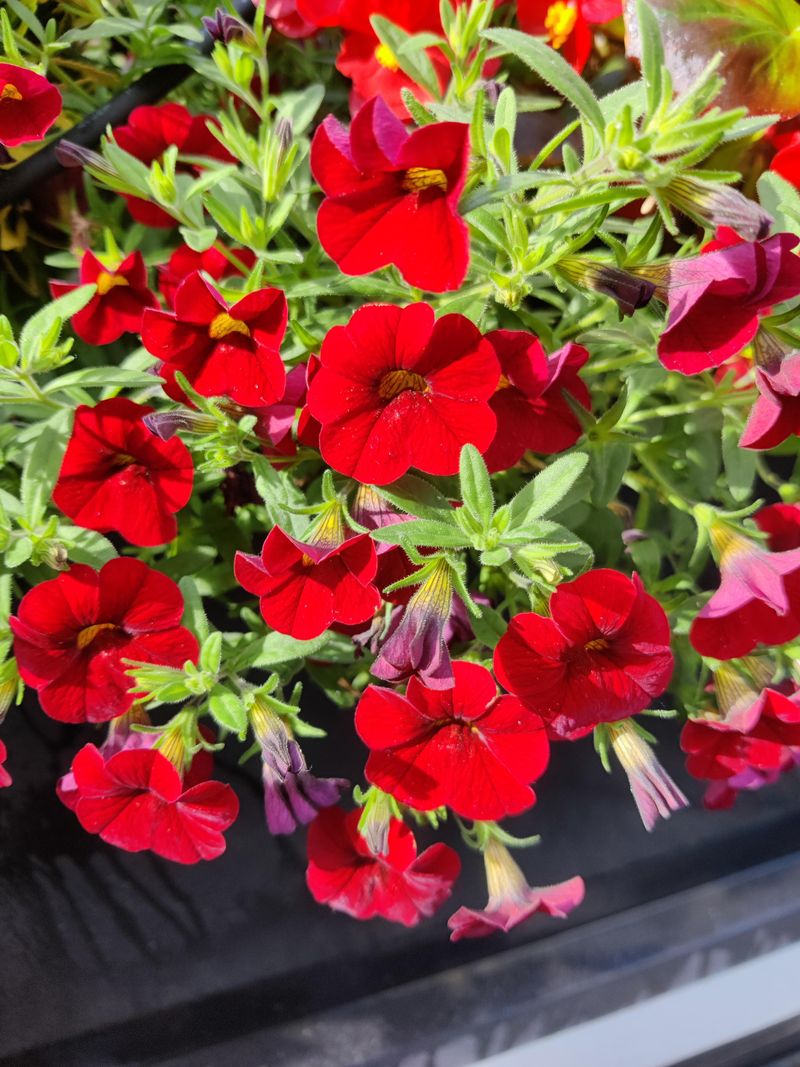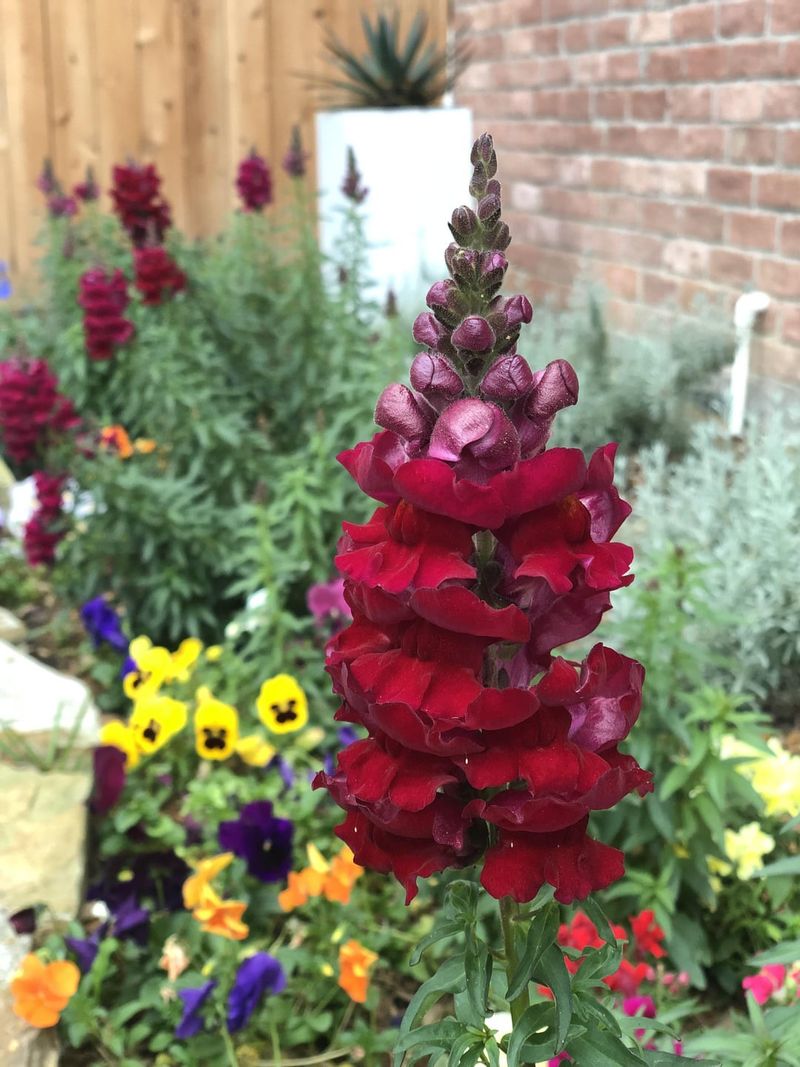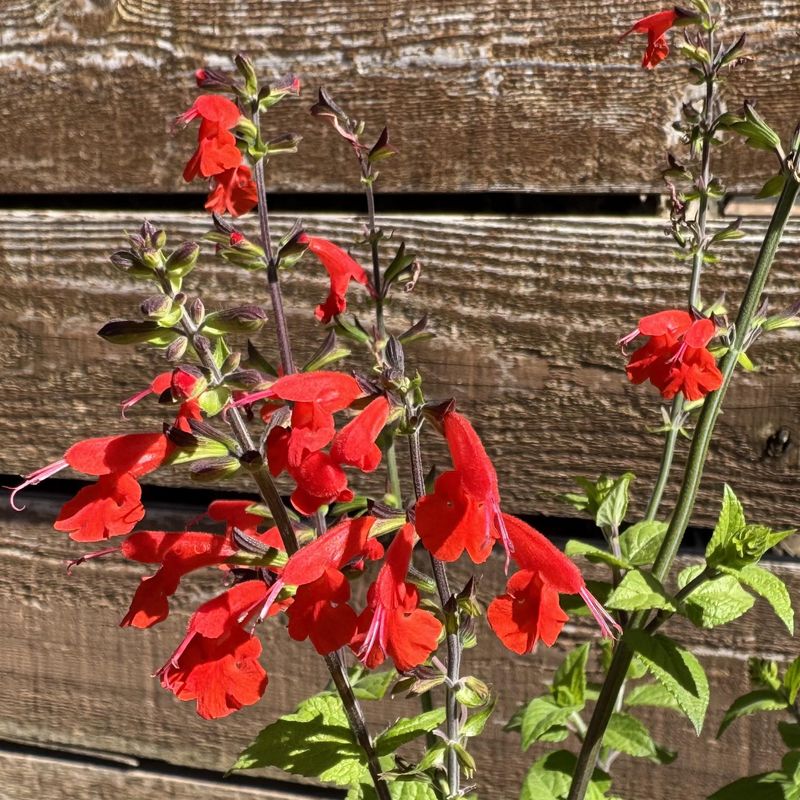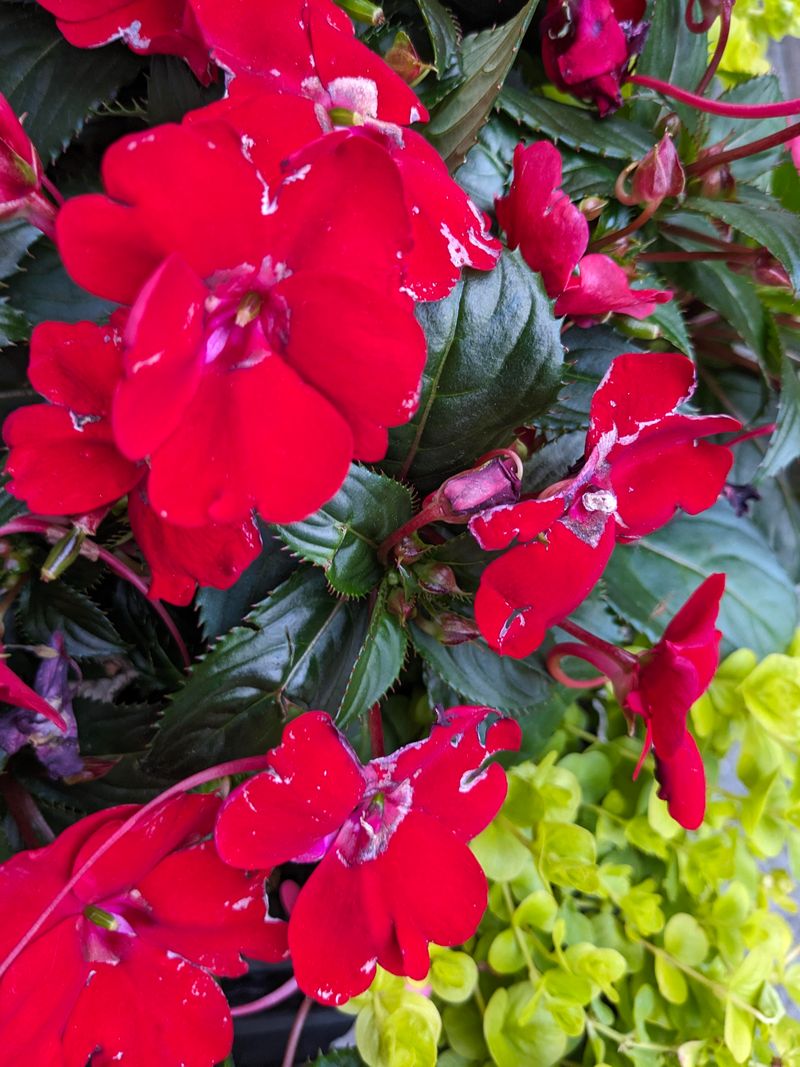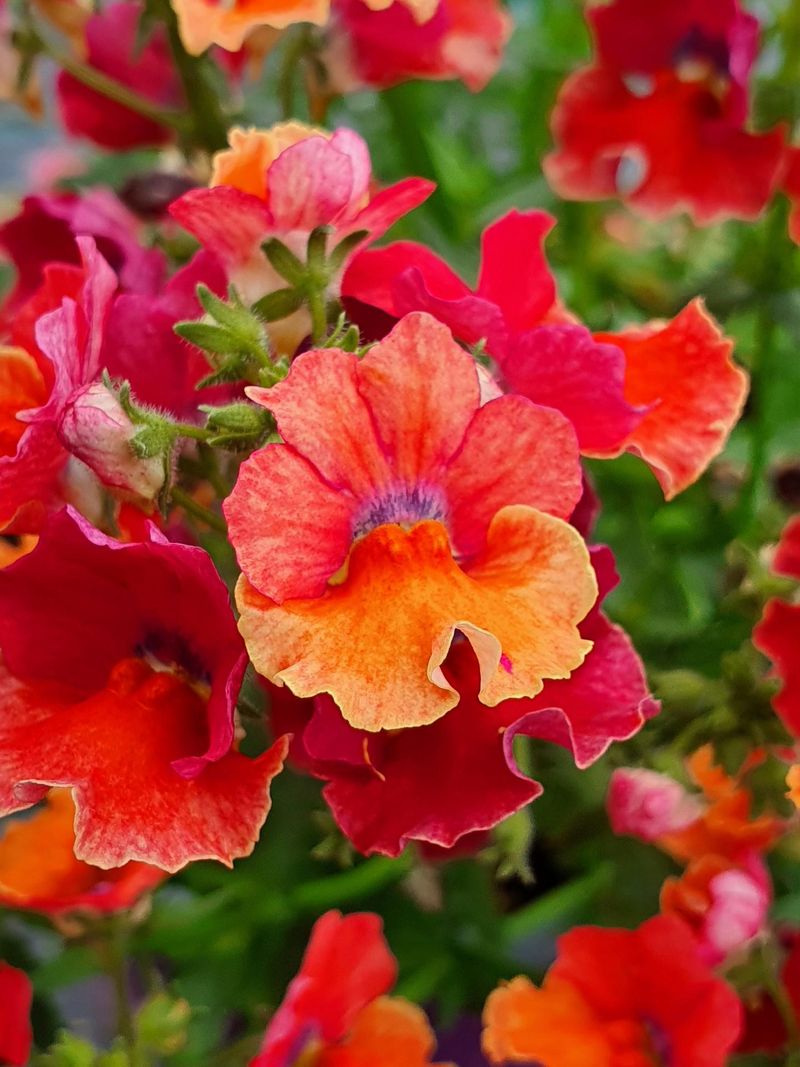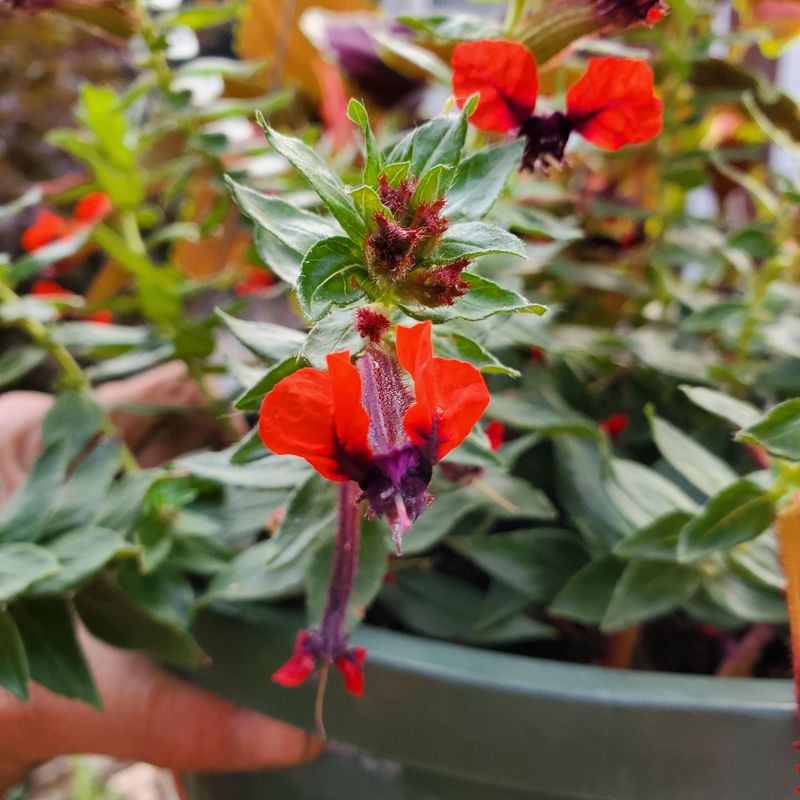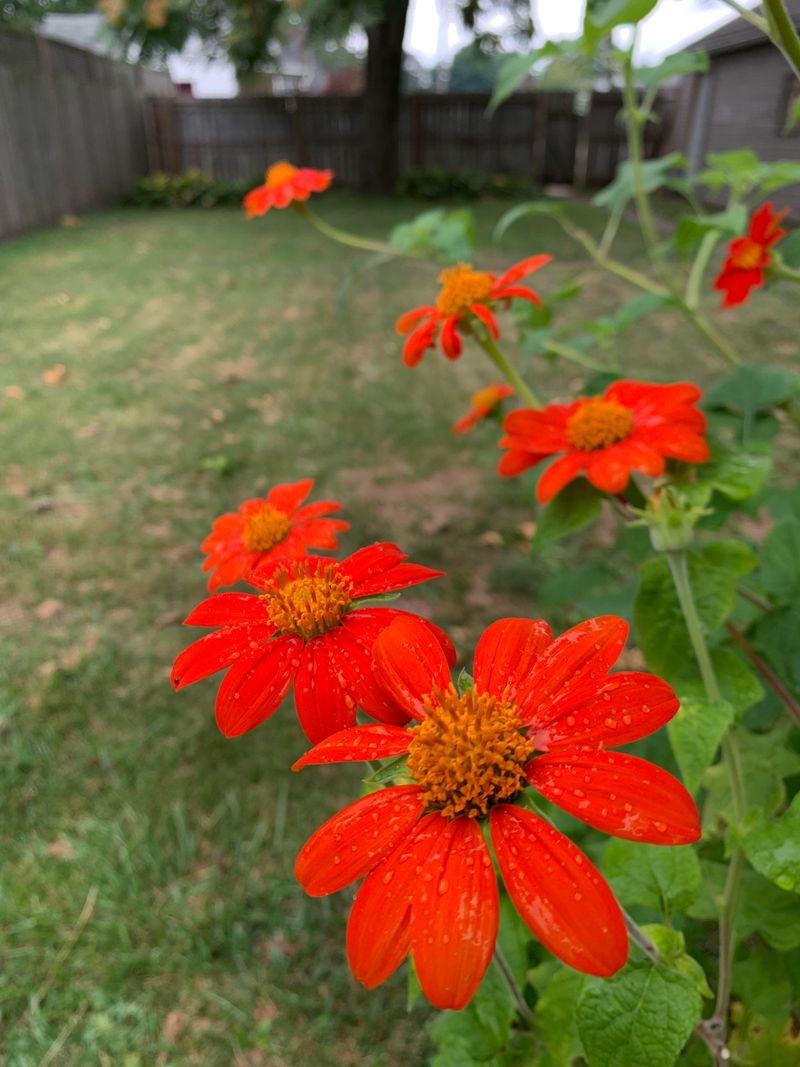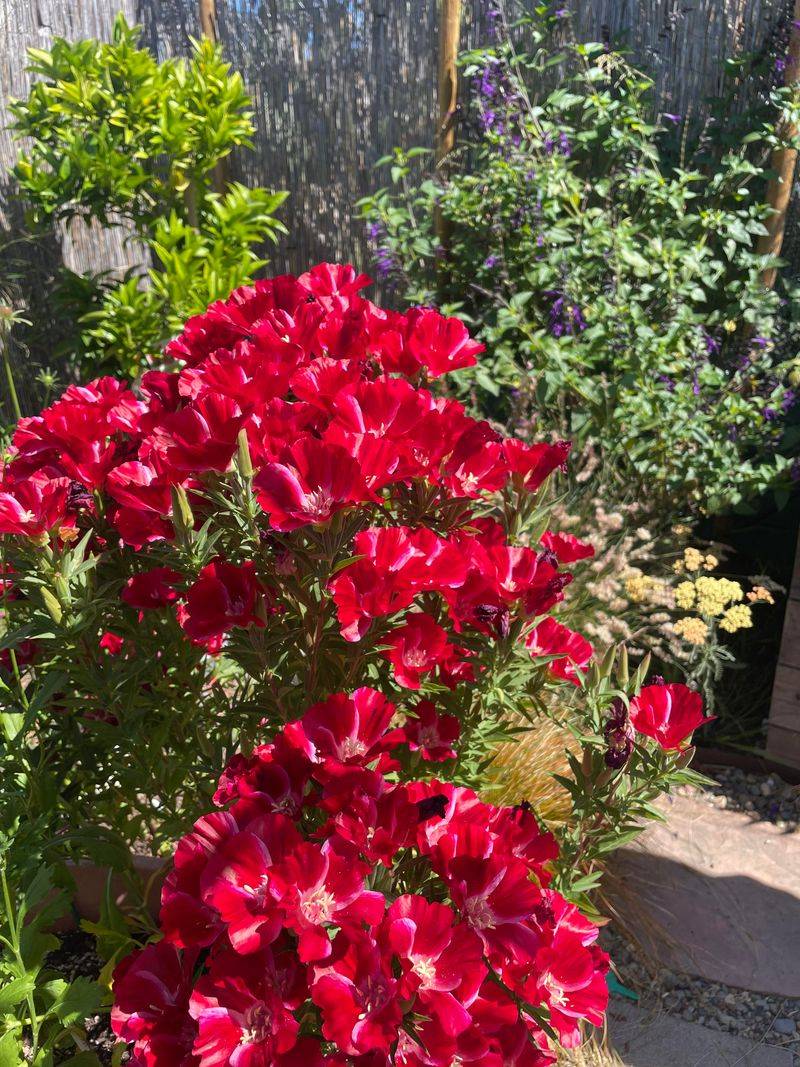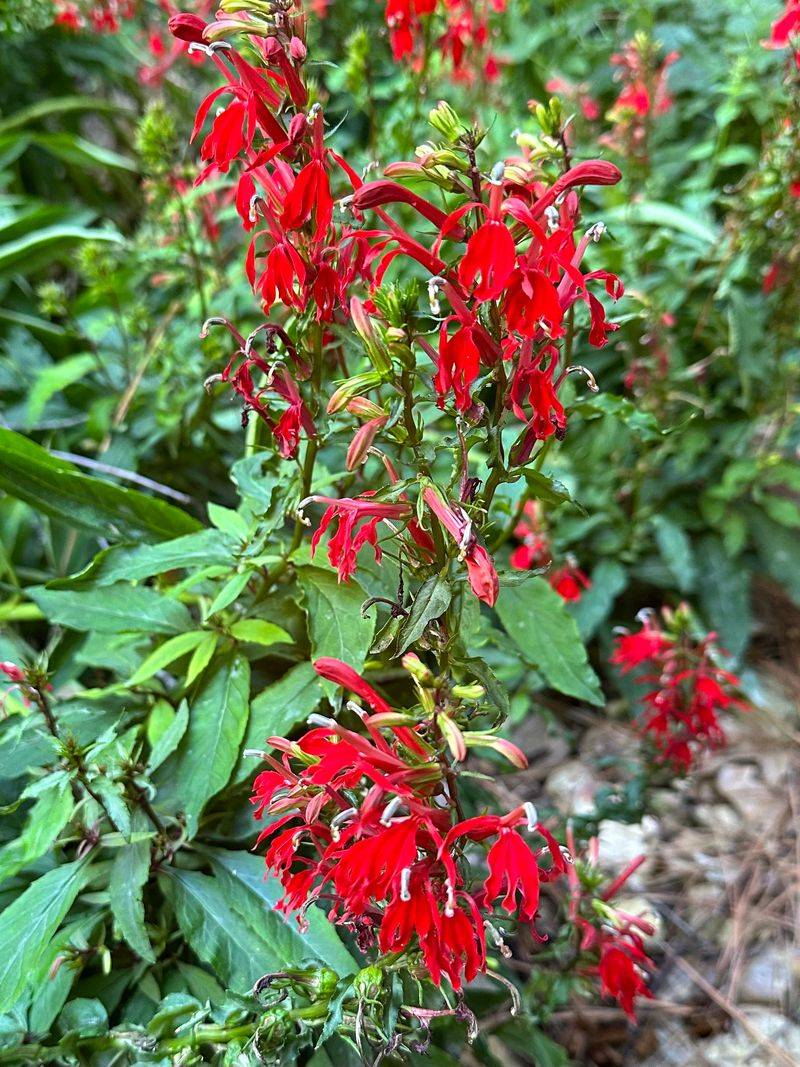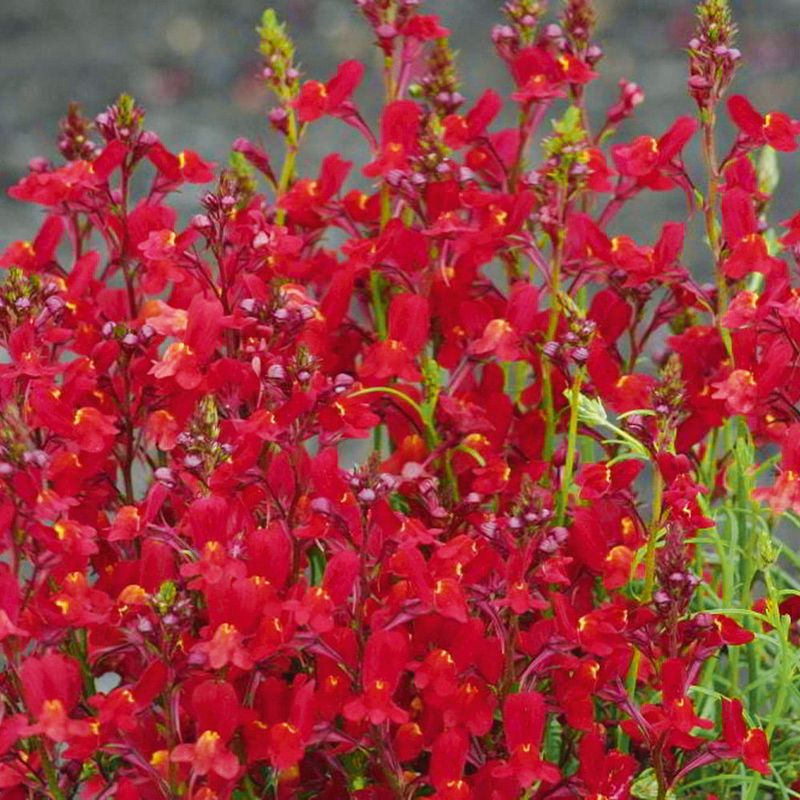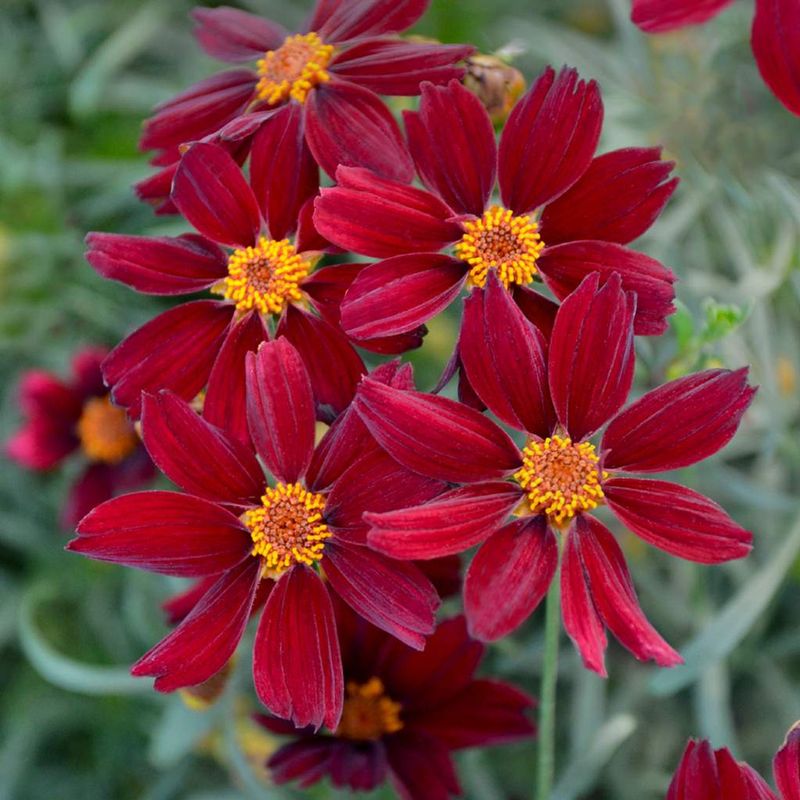Every garden can become a lively spectacle of color, especially when you include annuals that boast vibrant red flowers. Red, a color of passion and energy, transforms any green space into a dynamic visual feast. Each of these 28 annuals brings its unique charm, creating captivating focal points and lively backgrounds for your garden design.
1. Geranium
Geraniums boast vivid, velvety red blooms that instantly brighten up any garden or patio. With clusters of cheerful flowers sitting atop sturdy stems, they bring classic charm and rich color all season long. Their subtle scent and lush foliage make them a timeless favorite in both cottage and contemporary gardens.
These sun-loving beauties thrive in well-draining soil and full sunlight, making them perfect for containers and hanging baskets. They’re fairly drought-tolerant and only need moderate watering to stay happy. Deadheading spent blooms will keep the plant lush and blooming non-stop.
Try massing red geraniums along a garden path or mixing them with dusty miller and lobelia in a pot for a patriotic display. Their rich, red color also pops beautifully in monochrome garden themes or balcony boxes.
2. Petunia
Petunias are the quintessential summer flower, flaunting lush red petals with a velvety texture and subtle fragrance. They bloom in waves, spreading out with elegance and covering beds or containers with non-stop color. Their bold tones and mounded shape make them garden showstoppers.
Give them full sun, rich well-drained soil, and regular feeding for the most vibrant display. They’re surprisingly hardy and tolerant of heat, though deadheading will keep them at peak performance. Water deeply but infrequently to encourage strong root growth.
Plant red petunias in hanging baskets or railing boxes where they can cascade beautifully over the sides. For dramatic effect, contrast them with trailing silver dichondra or lemon-green sweet potato vine.
3. Salvia
Red salvia adds vertical drama and fiery color to garden beds with its spiky blooms and upright habit. Hummingbirds and butterflies can’t resist its nectar-rich flowers, making it a pollinator favorite. The deep red hue adds a wild yet elegant touch to summer displays.
Salvia thrives in full sun and well-drained soil, tolerating heat and even poor soil with ease. It’s best to water at the base and avoid soggy conditions, as it’s prone to root rot. Deadheading will keep blooms going well into fall.
Use red salvia in the center of mixed containers or behind low-growing flowers to add height and boldness. It’s especially striking when paired with ornamental grasses or yellow marigolds.
4. Zinnia
Zinnias deliver bright red, daisy-like blooms that light up flower beds with bold, joyful energy. These annuals are fast growers and bloom machines, adding instant cheer to any sunny spot. Their sturdy stems and big blooms make them popular for cutting gardens.
They love heat and sunshine and thrive in well-drained soil. Avoid overhead watering to prevent powdery mildew, and sow directly outdoors for easy, fuss-free results. Deadheading encourages nonstop blooms until frost.
Zinnias look stunning in large swaths or mixed into a cottage garden. Combine red zinnias with oranges and pinks for a sunset-inspired palette that bees and butterflies adore.
5. Celosia
Celosia’s feathery plumes or brain-like crests bring outrageous texture and brilliant red hues to any planting. This quirky flower adds a sculptural quality that instantly grabs attention. Its intense color and unique form make it feel almost otherworldly.
It flourishes in warm weather, full sun, and rich, well-draining soil. Keep soil consistently moist but not waterlogged, and feed occasionally to support vibrant blooms. Once established, celosia is fairly low-maintenance and tough in heat.
Plant red celosia in a bold grouping or border for a tropical vibe. It’s also fantastic in dried arrangements—just hang the blooms upside down to preserve their color and shape.
6. Impatiens
Red impatiens bring soft, glowing color to shady spaces where many flowers refuse to bloom. Their tender petals and mounded form add a lush, serene feel to garden beds and containers. These blooms look like velvet in low light, glowing with gentle elegance.
They thrive in part to full shade with moist, well-drained soil. Keep them evenly watered and sheltered from harsh afternoon sun. Pinching back leggy growth can encourage bushier plants.
Use red impatiens in mass plantings beneath trees or along shaded walkways. They also shine in hanging baskets and window boxes where direct sun is limited.
7. Verbena
Verbena offers clusters of fiery red flowers that spread and spill like a floral waterfall. Their continuous blooms and trailing habit make them a go-to for lush, spreading color. These flowers are sun-hardy and beloved by pollinators.
Plant them in full sun and well-drained soil for best results. Deadheading keeps them neat and blooming, and they’re quite drought-tolerant once established. Avoid soggy spots to prevent root rot.
Use red verbena in rock gardens, hanging baskets, or to edge garden beds with a cascade of color. They’re great companions for upright annuals like salvia or snapdragons.
8. Dianthus
Dianthus charms with starry, fringed red blooms that often carry a spicy-sweet scent. These low-growing plants form tidy mounds with masses of flowers that look great up close or from afar. Their silvery foliage adds an extra layer of interest even when not in bloom.
They prefer full sun to partial shade and well-drained, alkaline soil. Water at the base to avoid mildew and trim them back after the first flush to encourage reblooming. They’re cool-weather tolerant and one of the first to bloom in spring.
Use red dianthus along borders, in rock gardens, or mixed with ornamental cabbage for a cool-weather display. They also do well in window boxes where their scent can be appreciated.
9. Poppy
Red poppies offer delicate, papery blooms that sway in the breeze like living art. Their bold, silky petals and black centers are pure drama in the garden. They’re short-lived but unforgettable.
Plant poppies in full sun and sandy, well-drained soil. They prefer cooler weather and often bloom best in early summer. Sow directly in place since they don’t transplant well.
Let red poppies naturalize in wildflower patches or mix them with grasses for a meadow-inspired look. They’re also stunning in minimalist beds where their simple elegance can shine.
10. Marigold (French varieties)
French marigolds light up the garden with compact red-and-gold blooms that resemble little fireworks. Their frilly petals and bold colors make them a cheerful addition to any border. Bonus: their scent naturally repels pests!
They grow best in full sun with average, well-draining soil and don’t mind heat or dry spells. Water at the base and deadhead regularly to keep them looking their best. They’re quick growers and easy from seed.
Plant red French marigolds alongside vegetables to deter unwanted bugs. Or mass them in flower beds for a blazing summer border full of warmth and movement.
11. Begonia
Red begonias bring a bold splash of color with their waxy, vibrant blooms and glossy foliage. Whether upright or trailing, their flowers have a polished, jewel-like finish. They thrive where many other red annuals struggle—especially in part shade.
Plant begonias in well-drained, slightly acidic soil with filtered sunlight or morning sun. Keep the soil evenly moist but not soggy, and avoid getting the leaves wet to prevent spotting. They love warmth and humidity but can be sensitive to frost.
Try planting red begonias in urns or decorative planters for a classy touch near entryways. They also shine in shady beds under taller plants or trees.
12. Nasturtium
Nasturtiums flaunt vibrant red blooms with round lily pad-like leaves for a whimsical, vintage garden feel. Their flowers are edible and peppery, making them just as delightful on a plate as in the dirt. They grow fast and are irresistibly cheerful.
Plant in poor to average soil and full sun for the best flowering—too much fertilizer actually reduces blooms. They’re drought-tolerant and ideal for beginner gardeners. Water moderately and let the soil dry out between sessions.
Tuck red nasturtiums along borders, in window boxes, or let them trail from containers. Their edible flowers look stunning in summer salads or as garnishes.
13. Lobelia
Red lobelia is rare and striking, bursting with masses of tiny, fiery blooms on low-growing or trailing stems. It adds a soft, airy texture to garden compositions while delivering intense color. These beauties attract hummingbirds like magnets.
Grow in rich, moist soil with morning sun and afternoon shade for best performance. Lobelia loves cooler temps and may need a midseason trim to rejuvenate. Keep soil consistently moist, especially in containers.
Plant red lobelia in hanging baskets or urns where their trailing habit can spill elegantly. They’re also a perfect filler in mixed containers alongside taller annuals.
14. Portulaca
Also known as moss rose, portulaca brings brilliant red blooms that open in sunlight and close by dusk. Its succulent leaves and ground-hugging habit make it a water-wise groundcover. The petals look almost neon in full sun.
Plant portulaca in sandy, well-drained soil and give it lots of sunshine—it thrives in tough, dry spots. It’s nearly carefree once established, needing very little water. Avoid overwatering to prevent root rot.
Use red portulaca to fill in cracks between stepping stones, cascade from walls, or edge hot, dry beds. It’s also great for rock gardens or shallow containers.
15. Gaillardia
Gaillardia, or blanket flower, flaunts daisy-like blooms in red and orange that resemble a glowing sunset. These sun-lovers bring wildflower vibes with a punch of intensity. Their bloom time stretches from early summer well into fall.
They thrive in poor, sandy soil and full sun, and don’t mind dry conditions. In fact, they do better with a little neglect than pampering. Deadheading encourages even more flowering.
Use red gaillardia in wildflower meadows, pollinator gardens, or low-maintenance borders. They also look amazing paired with ornamental grasses or black-eyed Susans.
16. Cosmos
Cosmos offer delicate, feathery foliage topped with bold red blooms that seem to float in midair. They bring a breezy, romantic feel to gardens and self-sow generously for future color. Butterflies love them, and so will you.
They need full sun and tolerate poor soil like champs. Water sparingly and avoid over-fertilizing to keep them blooming. Deadhead for continuous color or let some go to seed for a natural look.
Use red cosmos in cottage gardens, behind low edgers, or to soften hardscape edges. They’re also fabulous as cut flowers in wild, unstructured bouquets.
17. Calibrachoa
Often called “million bells,” red calibrachoa explodes with tiny petunia-like flowers that bloom nonstop. These trailing plants are perfect for adding vibrant rivers of color to any space. They’re compact but oh-so-prolific.
They prefer well-draining soil, full sun, and consistent watering—especially in containers. A balanced fertilizer every couple of weeks keeps them thriving. Pinching back occasionally promotes bushiness.
Use red calibrachoa in hanging baskets, window boxes, or tucked into patio pots. They also work well as a colorful groundcover in front of taller annuals.
18. Snapdragons
Snapdragons bring rich, velvety red spires that add height and whimsy to flower beds. Their dragon-shaped blooms are irresistible to both kids and pollinators. With their upright form, they add structure and color all at once.
Grow them in full sun with well-drained, fertile soil. They prefer cooler weather and may bloom best in spring and fall. Deadhead to encourage rebloom and bushy growth.
Plant red snapdragons in rows along walkways or mix into formal flower beds for vertical interest. They’re also gorgeous in floral arrangements—cut them just before the buds open for longest vase life.
19. Scarlet Sage
Scarlet sage bursts with tubular red flowers on upright stalks that blaze like torches in the landscape. It’s a magnet for hummingbirds and adds bold movement to the garden. The deep, saturated red makes it a standout plant in any setting.
Give it full sun and well-draining soil to thrive. It’s heat-tolerant and relatively drought-resistant once established. Deadheading encourages more blooms and extends flowering into fall.
Use red scarlet sage in mass plantings or as a fiery backdrop in mixed borders. It also performs beautifully in large containers for patio drama.
20. SunPatiens
SunPatiens are a bold twist on the classic impatiens, thriving in full sun with red blooms that absolutely glow. Their lush, dense growth and non-stop flowering make them garden powerhouses. With glossy leaves and vivid petals, they command attention in any landscape.
They thrive in full sun to part shade and prefer moist, well-draining soil. Keep them well-watered during hot spells, and feed every few weeks for maximum bloom power. They’re resistant to downy mildew, making them more durable than traditional impatiens.
Plant red SunPatiens in bold swaths along borders or in large pots for maximum impact. They also make great fillers around trees or taller shrubs.
21. Nemesia
Nemesia may be petite, but its red blooms are intensely vibrant and delicately sweet-scented. These low growers form neat clumps of color, perfect for softening garden edges. Their snapdragon-like flowers bring a charming, old-fashioned feel.
They like cooler weather and bloom best in spring and fall, thriving in full sun to part shade. Keep soil evenly moist, and pinch back after the first flush to encourage more blooms. They prefer rich, well-drained soil.
Use red nemesia in containers near walkways or windows where their scent can be enjoyed. They’re also a great choice for front-of-bed color or fairy garden accents.
22. Cuphea
Cuphea, also known as cigar plant or firecracker plant, produces red tubular blooms that pop like little fireworks. These unique flowers are loved by hummingbirds and bees. With a compact, bushy form, they bring texture and motion to the garden.
Grow cuphea in full sun and average, well-drained soil. It’s heat- and drought-tolerant once established and blooms from spring to frost. Pinching back early helps shape the plant.
Try red cuphea in butterfly gardens, border edges, or in a mix with upright grasses. It’s also stunning in terracotta pots that show off its fiery colors.
23. Tithonia (Mexican Sunflower)
Tithonia flaunts large, daisy-like red-orange blooms atop tall, sturdy stems that tower over most annuals. These heat-loving giants are butterfly magnets and bring a wild, tropical vibe. Their bold presence is perfect for making a statement.
They love full sun and well-drained, lean soil—no fertilizer needed. They’re drought-tolerant once established and benefit from regular deadheading. Start from seed for best results, as they grow fast and bloom heavily.
Use red Tithonia at the back of borders, along fences, or to anchor a pollinator patch. Their blooms also make fabulous, long-lasting cut flowers.
24. Amaranthus
Red amaranthus is all about drama, with cascading tassels or upright plumes in deep crimson. Its bold, architectural shape makes it a standout in beds or bouquets. The leaves are sometimes edible and come in rich burgundy shades.
Plant in full sun and average, well-drained soil. It tolerates heat and dry spells, and thrives on minimal fuss. Deadheading prolongs bloom time, though letting it go to seed adds interest.
Use amaranthus in cutting gardens, as a focal point in containers, or in dried arrangements. It also brings texture and intensity to mixed plantings.
25. Clarkia
Clarkia offers delicate, ruffled red blossoms that bloom in charming vertical spikes. These wildflower darlings bring soft color and graceful movement to the garden. Their whimsical, upright habit fits perfectly in informal spaces.
Sow directly in cool weather and give them full sun to part shade. They like loose, well-drained soil and don’t need much fuss. Water consistently during dry spells.
Use red clarkia in cottage gardens, naturalized borders, or mixed into wildflower blends. They also look lovely in hand-picked bouquets.
26. Torenia
Torenia, or wishbone flower, delivers red-purple trumpet blooms that thrive in the shade. Their velvety petals and lush green foliage create a tropical, refreshing look. With a trailing habit, they’re ideal for hanging baskets and shady corners.
They grow best in rich, moist soil and part to full shade. Water consistently and deadhead to encourage more flowering. They’re great for humid areas and can tolerate summer heat in shade.
Use red torenia to brighten dark spots on porches or under trees. They also make charming accents in woodland-themed containers.
27. Linaria
Linaria, or toadflax, features delicate, snapdragon-like red blooms that dance atop airy stems. Its fine texture and wildflower appearance add lightness to any planting. Bees love the small blossoms that bloom in abundance.
Sow directly in full sun and lean, well-drained soil. It’s drought-tolerant once established and often self-seeds. Keep it lightly watered during dry spells.
Try red linaria in wildflower gardens, rockeries, or along fences for a meadow-inspired feel. It also blends beautifully with grasses and other fine-textured plants.
28. Coreopsis (red hybrids)
Red coreopsis hybrids bring a twist to the classic yellow daisy-like flowers, adding bold, wine-red tones. Their cheerful blooms cover the plant like confetti from summer through fall. They’re long-lasting, pollinator-friendly, and just a little unexpected.
Grow them in full sun and average, well-drained soil—they’re very tolerant of poor conditions. Water sparingly and deadhead for extended bloom time. They’re tough, cheerful, and easy to grow.
Plant red coreopsis in sunny borders, mass plantings, or gravel gardens for a sea of color. They also play nicely in low-maintenance xeriscapes.

